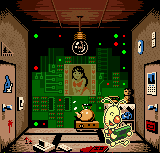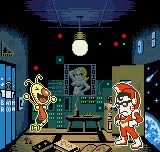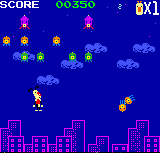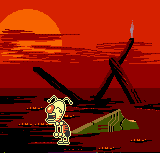This article is part of the NeoGeo Pocket Color: 10th Anniversary retrospective.
I wrote about this game before in 2003, but these are my updated (and hopefully final) views.


If you take a group of artists that has been denied meaningful creative freedom for years, and give them carte blanche to make what they want, the result is typically going to be a glorious, undisciplined shambles. (Ever seen The Monkees’ film?) Thusly, when SNK’s developers were allowed to make something for the NGPC that wasn’t yet another fighting game, they delivered what has to be the most peculiar game on the system.
Ignoring Pokémon for once, Ganbare Neo Poke-Kun takes its inspiration from that other great portable gaming craze – Tamagotchi. It presents a window into the life of Neo Poke-Kun, a hapless, big-headed homunculus who lives in a dingy bedsit inside the NGPC’s circuits, and follows a routine based on the system clock.
Poke-Kun differs from a typical virtual pet in that rather than having to feed and water him, the player is given responsibility for his emotional wellbeing. This is quite a tall order, as the methods of interaction available are intentionally extremely limited, indirect and unpredictable.


One of the few actions available is summoning a (random) visitor to Poke-Kun’s front door. Each visitor has a number of brief ‘skits’ that they can perform with Poke-Kun. Some make him happy or excited, but most annoy, embarrass or physically abuse him in some way. All are bizarre and inexplicable – a racing driver, a giant nose, a man who skips rope with his moustache, a dog in a leotard that fouls itself, and worse. The cast of visitors is extensive, with new and stranger ones being introduced over time.
By waggling the joystick you can cause some misfortune to befall Poke-Kun, from dropping a pan on his head, to burning his house down. It’s not clear what purpose this serves. The intention might simply be to thumb the nose at control-mashing players frustrated at the lack of interaction.
The actual ‘game’ part comes in when you elect for the third and last available action: sending Poke-Kun to work. Assuming he’s in a good enough mood, he’ll slowly ‘build’ minigames which you can then select from a menu. There are thirty minigames in all, divided into tiers of increasing complexity, effectively parodying different eras of gaming. Starting with Pong and Asteroids, Poke-Kun tries his hand at a wide range of genres, culminating in ‘modern’ fighting and dancing games.
Even though their style becomes progressively more sophisticated, all of the minigames are quite simplistic and shallow. Some are enjoyable time-wasters (the one involving dodging lava spewed from a volcano is particularly well balanced) but just as many are tedious, frustrating or hampered by clumsy controls.


With the benefit of hindsight, it seems obvious how Ganbare Neo Poke-Kun could have been made much more compelling as a conventional game. It contains all the component pieces (referential minigames, minimal controls, bizarre visual humour) which Nintendo later used to make the WarioWare games, but the designers just never had the eureka moment of realising that there was a better way in which they could be slotted together.
What we’re left is a game that doesn’t have any interest in pandering the conventional criteria by which games are judged. Some will see it as a stupid unplayable mess, or an “art game”, but (like its host platform) it’s an interesting failure.
Score: A tortoise looking at you balefully/10
Developer/Publisher: SNK
Supercede-o-factor: It’s unlikely that anyone will ever try to replicate Ganbare Neo Poke-Kun. The “IP” is linked too closely to the NGPC for there to ever be a direct sequel. WarioWare, Ouendan and Rhythm Heaven all have a similarly irreverent sense of humour, and all work better as games.
Next: Conclusion
Tags: game title, ganbare neo-poke kun, handheld, neogeo pocket color, ngpc, snk, virtual pet, wtf
